Meg Stuart/Damaged Goods, working in both Brussels and Berlin, visits NYU Skirball
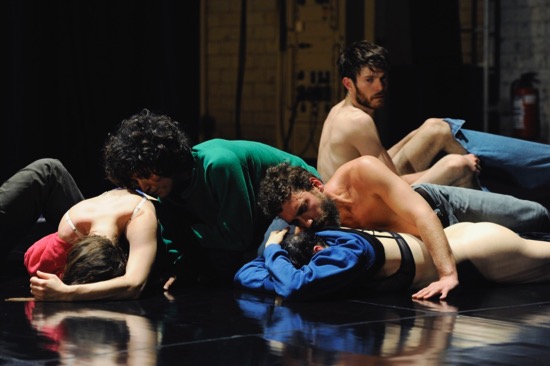
Members of Meg Stuart/Damaged Goods in Stuart’s UNTIL OUR HEARTS STOP. (L to R): Kristof Van Boven (knee only), Claire Vivianne Sobottke, Leyla Postalcioglu, Maria F. Scaroni (in blue), Jared Gradinger, and Neil Callaghan. Photo: Iris Janke
The first time I try to access the website of Meg Stuart/Damaged Goods (based in both Brussels and Berlin), the screen says only “try to explode;” when I enter it again later, it tells me, “you have to embrace accident.” I think I’ll try the second now and save the first until later.
Seeing Stuart’s 2015 UNTIL OUR HEARTS STOP at NYU Skirball last week, I regretted again not having seen more of her remarkable, mind-bending choreography, and that every work I had seen (except for those she made while getting a BFA from NYU-Tisch in the 1980s) was for only two or three people: Forgeries, Love and Other Matters (2006), BLESSED, and Maybe Forever (both 2007). She has worked on over thirty pieces since she formed her company in 1994.
Sitting in Skirball, it’s hard to tell what’s being improvised and what came out of improvisation and was then set. Everything the nine performers do looks either as if it’s being decided upon that moment or as if it’s gotten slightly out of hand. The stage (lit by Jurgen Kolb and Gilles Roosen) appears to have been recreated to look like the company’s Brussels studio during rehearsals. Purple flooring surrounds a diagonally-set square as shining as a pond. A couch sits on one side, a piano on the other. At the back, there’s a freestanding fake door, a tall red curtain, and a staircase. Behind vertical slats, you can barely glimpse the lights on what might be a Christmas tree; sometimes its bulbs are colored, sometimes white.
So what is this place? A studio, a playground, a theater, a physical therapy office, or all four? In it, games happen; so do magic tricks, so does massage. Dancers invade the audience at one point. A couple of people we’ve never seen before briefly appear onstage as if by sorcery and are introduced to us (they’re smoking). Wherever we are, in addition to Skirball, it’s an interesting place and, at times, a shocking and/or dangerous one.
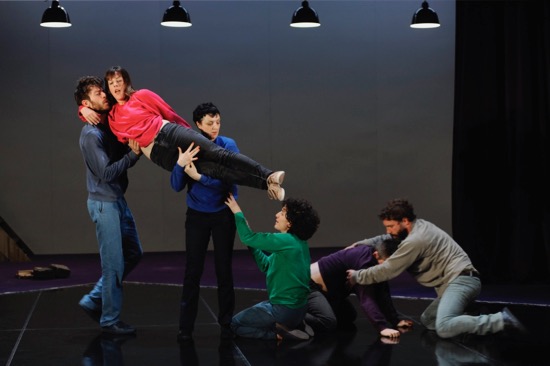
The cast of UNTIL OUR HEARTS STOP (L to R): Jared Gradinger and Maria F. Scaroni lifting Claire Vivianne Sobottke, Leyla Postalcioglu, Kristof Van Boven, Neil Callaghan. Photo: Iris Janke
In the beginning, we can’t be sure who’s male and who’s female, who’s a dancer and— except for Samuel Halscheidt, tuning his guitar on one side—who’s a musician The boyish person with a mop of black hair, wearing a loose-cut green top, turns out to be Leyla Postalcioglu; the one with a very short haircut is Maria F. Scaroni. So, with Claire Vivianne Sobottke, that makes three women. The three men dancing are Neil Callaghan, Jared Gradinger, and Kristof Van Boven, but a fourth lying with his face on the shiny floor, as if it were a pond, turns out to be Marc Lohr, the drummer, and one of the bearded guys, Stephen Rusconi, eventually goes to the piano, where the three are to play music—fiercely, delicately atmospheric, often silenced—originally created by Paul Lemp.
UNTIL OUR HEARTS STOP makes you aware of the many ways in which skin encounters skin (these performers have studied various mind/body disciplines, including releasing techniques). They begin slowly: one goes down on his hands and knees, and someone sits on his back; another sits, and a colleague stands on her thighs. Twosomes become threesomes. Three dancers, say, form themselves into a compact ball. These explorations gradually involve more people and become more and more complex, risky, barely counterbalanced. Two men scrabble fiercely and get pulled apart, not without effort on the part of those who want to separate them.
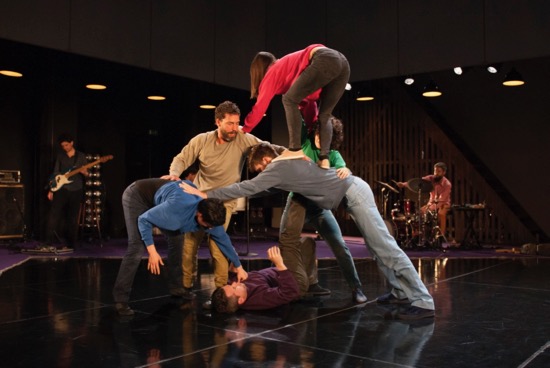
Meg Stuart’s UNTIL OUR HEARTS STOP. (Clockwise from bottom): Kristof Van Boven, Jared Gradinger, Claire Vivianne Scaroni, Leyla Postalcioglu, and Neil Callaghan. At back: Samuel Halscheidt (L) and Mark Lohr. Photo: Maarten Vanden Abeele
In one scene, the dancers have gradually assembled on the couch; they’re already crammed together when Callahan, having taken off all his clothes, comes over, sits on someone’s lap, and somehow forces his way between two of them. He’d like to sing and sort of does. Pianist Rusconi touches the keys. But those on the couch begin to slide down; clothes come off. They sniff a foot, rub a cheek against a chest, push a face between someone’s thighs. This is not exactly erotic; it’s more like sleepy puppies at play.
At a later moment, one of the men plays therapist, stroking the chests of two colleagues and then slapping them HARD. Later still, off to the side, Gradinger gradually piles lumps of clay (or something like it) onto Van Boven’s head, completely covering it, and leads him to another spot, where he falls forward onto his face; Gradinger then picks up a hunk of the stuff and drops that on his head too. The audience groans. Not to worry folks. Van Boven is okay! Magic! (I’m not sure how to interpret this act in addition to acknowledging it as a trick. Sealing off someone’s senses? A seemingly sadomasochistic test performed as if it were a form of healing?). Part of the time, I’m looking elsewhere, maybe at two of the women (Scaroni and Postalcioglu, I think), who sit on their heels, grasp hands, and twist until they kiss, then reverse directions and kiss again; they keep doing this slowly and carefully, as if it were a special exercise in which they’ve been coached.
UNTIL OUR HEARTS STOP is a good title for this piece. It lasts for two intermissionless hours, and the extraordinary performers perform extraordinary acts and get little rest. Clothes are shed (even by drummer Lohr) and put back on or exchanged for fresh ones. Occasionally I discern an influence on Stuart by Pina Bausch. Vignettes appear, are developed, and disappear. Actions, however startling, may be repeated without comment or response.
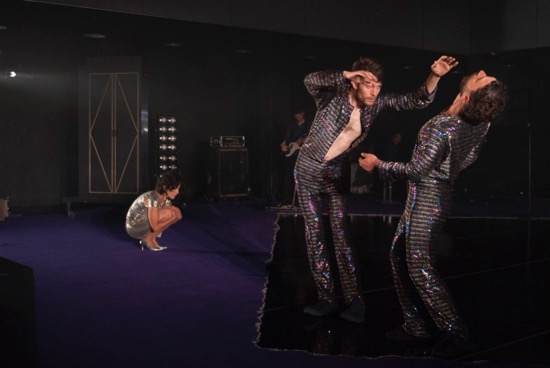
Near the end of Meg Stuart’s UNTIL OUR HEARTS STOP, Neil Callaghan (L) and Jared Gradinger spar. Far left: Leyla Postalcioglu.Photo: Maarten Vanden Abeele
As in certain of Bauch’s pieces, Stuart at one point breaks that fabled fourth wall between spectators and performers, but more intimately. The house lights come on, and a performer walks up the aisle offering water. In the row just behind me, Gradinger, chatting companionably, ties two amused members of the audience together. Van Boven tosses what he says are the keys to his Paris apartment in our direction; someone gleefully catches them. Callaghan entices a very young woman from the audience into the “door” that turns out to be a magician’s box. He turns it, opens it: she has disappeared! He wheels the box to the sidelines. Nothing much is made of this, and a while later, his “accomplice” reappears in good shape from downstage right. No “tada!” though. The Skirball audience seems very happy with all this.
Do these performers “dance?” You may well ask. If you mean, do they congregate and throw themselves into some steps they all know? Rarely. Does the moment in which two of them spin while holding each other by a hand in his/her mouth count? The point is that these people are engaged in extremely physical acts a great deal of the time.
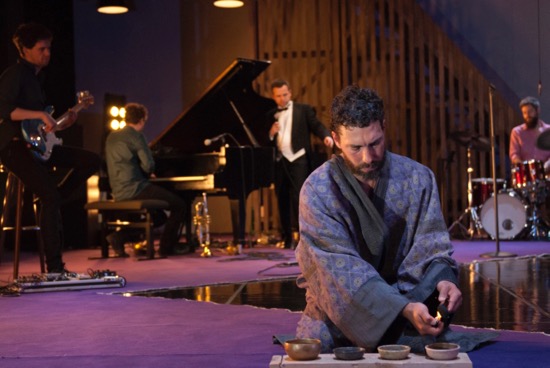
UNTIL OUR HEARTS STOP. At back (L to R): Samuel Halscheidt, Stefan Rusconi, Marc Lohr. Foreground: Jared Gradinger. Photo: Maarten Vanden Abeele
Most of them get a chance to rest when Van Boven descends the staircase at the back and, dressed in tails, stations himself near the piano and a handy microphone. There he gives a brilliant performance of a man ill at ease in whatever situation this is supposed to be. Soft, intermittent whistles from the back of the house worry him. Sometimes he barely whispers into the mic. He leans on the piano; one foot occasionally kicks backward as if of its own accord. Pianist Rusconi listens sympathetically. I wish I could tell you some of what Van Boven revealed to us; often, it got us laughing. He did mention Trump.
I start to tire (long day, short night), and, for me, the piece begins to lag. Gradinger and Callaghan appear in silver-sequined attire and fight in slow motion without hitting each other. Postalcioglu comes onstage in heels and a silk dress, blindfolded and groping. After a while, Gradinger, having donned a robe, lights pots of incense that he’s carrying on a tray. So much to take in, remember, try to connect, ponder. . . .
The nearly last moments really evoke Bausch. Sobottke takes the mic and begins talking to us. She likes us. Wouldn’t it be nice if someone would volunteer to take the whole company out to dinner now? No takers? Well, could anyone just convey her to her hotel? That could be fun. She talks faster and faster, escalating her offer into further improbability, while the piece winds down around her.
By the end, everyone, including her, is onstage, wearing the sweatshirts and pants in which they began the evening. Perhaps the whole hypnotic show was a dream in which an array of performative acts slid around together. Maybe the dreamers woke up sometimes, maybe not. Anyway, we clap long and loud for what they’ve shown us and for all that they’ve made us contemplate. I think, after all, that I won’t try to explode. Maybe tomorrow.
